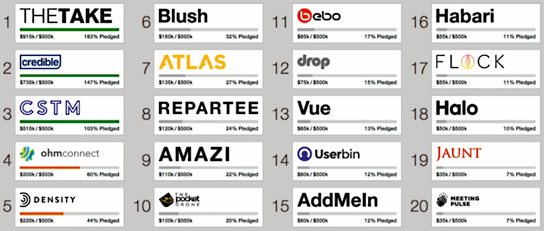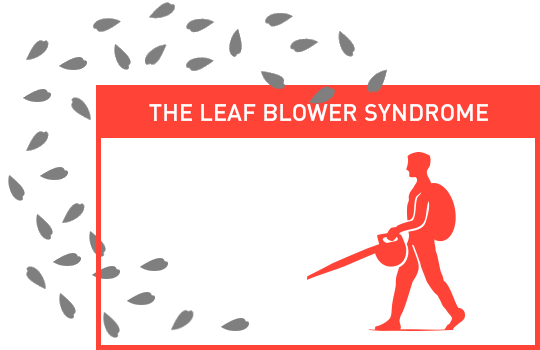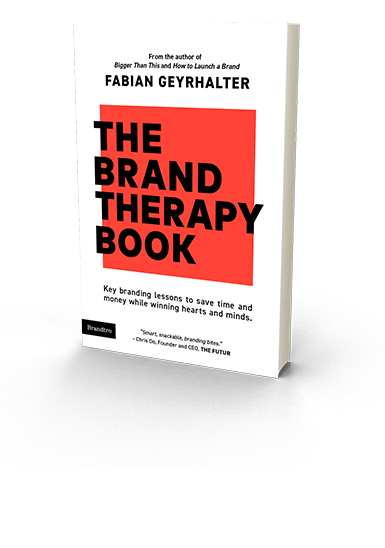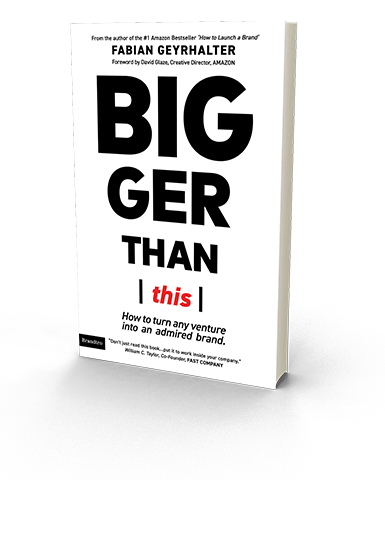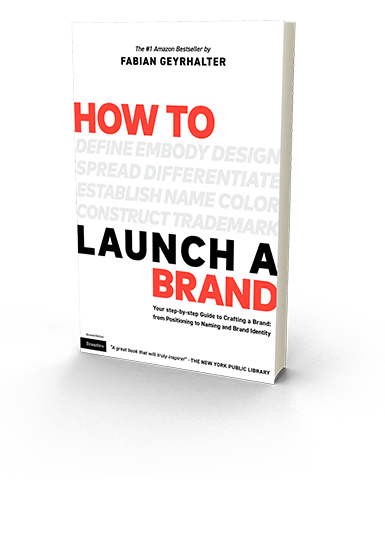Author Archives: Fabian Geyrhalter
Rapid-Fire Brand Name Advice
On this blog I already talked about what makes a name successful and how to pick a domain name, but many of you ask if I find a fabricated name to be superior to a descriptive name, and how to best navigate the types of names that one can consider, quickly. Short and actionable, I’ll give one sentence of advice on each type of name. 3, 2, 1, go: Descriptive Example: Match.com Advice: Great as it immediately conveys what it is/does – only if you will never expand your product offerings – but limiting and hard to find a sound domain name Metaphor Example: Puma Advice: Not a top choice as existing connotations, domain name difficulties and Search Engine results can quickly come in the way for a new company Founder Example: The Bill & Melinda Gates Foundation Advice: Great if you are the brand, you already have a legacy and if you are Bill, and not Lance Fabricated Example: FINIEN Advice: It’s genius, of course! In all seriousness, it is a great path, if easy to pronounce and recall, and backed by a great story Acronym Example: AOL (America On-Line, Remember?) Advice: A solid option to sound like a larger company from the start; only if your customers can recall your letters and if you can get hold of a reasonable domain name (sorry, three- or four-letter combos are all sold out) Fabricated x Acronym Example: Wanelo (Want, Need, Love) Advice: Great option if tied to a …
Your New Company’s ‘Stick’ – When Branding Helps Create And Save Your Venture
Ask yourself: Am I about to launch a product/service, or a brand? How would you know? You may not have a direct competitor yet, but you soon will. When the innovative, new and unique wears off, competitors will offer your product at a lower cost. How will you keep your customers from choosing their product instead? What will it be that will make your offering stick? Too many startups have to re-invent, re-brand and re-connect once they find traction – at a high cost. If you have a unique offering combined with ‘the stick’ – the set of true differentiators, the emotional connectors that deliver from the inside out, consistently on message (visually and verbally) and on target – you know you have a brand. Having that foundational special ingredient is like a survival formula for your startup, it will make customers come sooner, faster and stay around even if they could save a few bucks elsewhere later on. @i_mdoughboy tweeted the following last week about my consultancy’s process chart (see below): Guess where the value is? Here’s a hint – the graphic is eerily similar to a bullseye. Imagine you are a gifted craftsman that has mastered a unique design that you developed over the course of years just to sell very few and at a high price as you don’t have the audience nor infrastructure. You created something truly unique that only you offer. After years of work, but only a few units sold, you see your …
Walking The Talk In Silicon Valley – What Mattered At The 2014 LAUNCH Festival
I spent the first half of my week in the land of the nouveaux riches and the fail-backwards-wannapreneurs, the starving startups and the über (Pun!) rich venture capitalists, the land of income gaps and the building of bridges for such; it was an experience that was well worth having and well worth sharing. Jason Calacanis is a VC mogul, an entrepreneur, and blogger, but most important, he is a man with an opinion that he is happy to share, like most of his big-player pals. Jason built an empire, and for 3 days a year he opens it up to us. Startups attend for free, the rest of us pay our dues. Startups spend the days prior inventing and building, VC’s meeting, and then in a grande finale they sign checks. Just like the one for $50,000 to two young adults from Warsaw who looked like deer in headlights on stage, not knowing what just happened to them over the past few days; from arriving, to forming a company, to getting checks from Jason and the (rather mesmerizing) leader of the cult-VC pack, Mark Cuban (Dallas Mavericks, Shark Tank Etc) with 9,000 attendees watching their acceptance speech. They told us they will now move to the US. On the same day that a Google glasses wearing female was attacked outside a bar (‘Glassholes’ they call them) and Mt. Gox came tumbling down, I saw a shocking amount of both, ladies wearing Google glasses and Bitcoins being freely distributed. Inside the …
Tackling Your New Brand’s About Page: 4 Tips On How To Say Less, Edit More, And Make It Resonate
I was born in Austria. English is my second language. Yes, I write a lot, but I do it because I want to share my expertise, not because I believe that I am a great writer. Yet today I set out to blur the lines of copy writing, branding, enthusiasm, content strategy, your target audience and content overload. Launching your brand puts an emphasis on the About section of your web site, no doubt about it. Even if you have a video and to-the-point messaging on the Landing Page(s), the About page will be sought-after. It needs to explain the following in a swift manner: What you do (Mission/Product Or Service Intro) Who you do it for (Target Audience) How you differ (Differentiators) Why I should care (Connect Emotionally/Value Proposition) What I should do next (Call To Action) That’s a lot to convey on a single page and therein lies the problem for an enthusiastic entrepreneur who writes this important piece of content in a stream of consciousness (it is after all the subject you know best), then quickly proofs it, and by the push of a button publishes it. Rarely do they look back. Yet another item checked off the busy to-do list. Then the journey of marketing and metrics hits in and the About page, long forgotten, is like ‘a ghost employee’ in a well functioning company; it lives on yet it should have been let go and replaced a long time ago. I know this feeling well. …
What Is An Entrepreneur’s Biggest Pain Point When Launching A Brand? The Answer May Surprise You.
Working with startups on developing new brands on a daily basis, we had a pretty good idea about our clients’ key struggles, but we reached out to entrepreneurs purchasing our book and asked them what they perceived their biggest hurdles to be. Here are their top 3 pain points: 1. Positioning my new brand (46%) 2. Developing a successful digital presence (21%) 3. Naming the Brand (14%) Are you surprised? I was. Not about the fact that positioning is the most important component of a brand launch. After all, it is the one that takes the most out of entrepreneurs as it requires a refined mixture of many diverse skills – creativity, industry insight, foresight, process and honesty (among others), and it is something that is very hard to create in a silo. What did surprise me was that entrepreneurs see the importance of positioning so clearly and that they are humble enough to acknowledge the DIY approach might not suffice when it comes to this aspect of their brand launch. Positioning is at the core of brand development, it forces you to answer the question Why, long after the questions What and How have been settled in your mind and you have decided that there was a need and you had the means to start that new business, or create that new product. The direction of the business has been set, but the direction for the brand has yet to be created (and synced). I believe most …
How Oversharing Creative Options Will Hurt Your Brand (On Hand of The Worst Magazine Cover Design of 2014)
When I was 8 years old I started ‘a publishing house’. I named it Buttersemmelweich Verlag. A real memorable name, right? It translates to ButterBreadSoft Publishing Co. It only published a single magazine, but over the course of several years. It was called SNOOPY. Go here for a stunning visual I dug out from the family archives just for you. Please note the Nike logos on Snoopy’s shoes, a sign of innocence lost and a hint of my future in branding. Perhaps the Charles M. Schulz Museum (which I can highly recommend a visit to) will sue me for the 6 issues I sold – yes, the young entrepreneur that I was I actually asked my family members to pay for my work. Just like a retainer, each issue I drew and wrote was copied 6 times (by my mum) and always sold out (to my mum Etc). As I grew a year older the name of the magazine was changed to JoeCool, an obvious transition, and I brought on ‘a partner’ as one ought to do, especially since I could not use the typewriter yet. My fascination with magazines grew over the years. As a young communication designer I felt the need to be on the forefront of pop culture, to be informed about as many topics as I possibly could in a swift and constant manner, while being surrounded by the freshest fonts and layouts. Since the internet has not quite been as giving back then as it …
The Leaf Blower Syndrome
I am not sure about you, but I can not stand leaf blowers. The concept does not work for me in any way. Now if you live outside the US, or in a region that has sane laws restricting or prohibiting the use of such evil devices, you may not know what I am referring to. The concept is simple: Leaf blowers use high pressure air, like a fan or hairdryer on steroids, to move leaves from one area to another, most often this means your gardeners blow them to your neighbors, or onto the street. Problem solved? Not quite. Either your neighbor hates you now (even a bit more), or the wind blows them back to you, eventually. Solution? Have the leaf blowers come by more often. Now that I filled you in, let’s do this again: The Leaf Blower Syndrome: Brand Identity of Startups Leaf blowers postpone an issue, while displeasing everyone who gets in touch with them. It stinks up the neighborhood, is annoyingly noisy and pushes a problem from one place to another. Bingo! Out of sight – out of mind. Now that was quick and cheap. Consider those massive amounts of leaves handled. On my way to our office last week, my thoughts deeply entrenched in the world of branding (as you’d expect), leaf blowers pushed their leaves smack onto a busy street during rush hour traffic. As I passed them I saw those leaves go absolutely everywhere; mostly right back to where they …
Why Our Brand Consultancy Doesn’t Have An In-Your-Face Splashy Logo
For a consultancy that has a clear focus on brand creation, you might have wondered at some point why we did not create a stunning icon or a splashy in-your-face logo for our own company. Are we not following our own rules, are we lazy, or is there a different strategy at play? Ask no more, the myths will be busted today. I decided early on, even with my former company, Geyrhalter & Co, that designing a logo in its truest form for a business that is in the business of designing logos would not be the right path – it could only back fire. It might be too ornamental, too colorful, too round, too square, too bold, too…anything really that does not fit our prospects’ bill of decorative wishes and likes. We do not want to attract clients based on a graphic style, nor would we want to scare them away using a specific style. We are in the business of creating your brand, ours should remain in the background. In other words, it’s a bit like the design of a logo for an exclusive car seller that focuses on the newest and most luxurious models. He decides to have a visual representation of a Tesla turn into the logo. It represents a true cutting edge car while surely representing luxury. To him. And only today. A dumbed down comparison, I know, but you get the point. A brand identity design (through its 3 components) should describe what you …
How to Leverage the 3 Core Components of Your Brand Identity to Enhance Messaging
When we think of brand we first think of logo (even though we know a brand is much more than its logo). The logo is the key point of visual interaction with a brand, hence we are likely to recall it every time we think (or talk) of – or write about – a brand. During the brand identity (‘logo‘) design process entrepreneurs often forget that there are 2 other elements that help tell the company or product’s story. They interact and bring value to the brand identity as a whole. Do not repeat the same message, but instead ensure to leverage these 3 core components to create a stronger, deeper brand message: If your name describes your business, do not focus on showing the same message in your logo; instead use your logo to talk about other key elements that describe and differentiate your business. If you are in the cloud storage business and your name includes the two words cloud and storage (A bad company name, yet good example: Cloud Storage Ninjas), have your logo visualize security and stability, if those are key components of your brand’s message. Contrary, if your name is nondescript, either fabricated or an acronym, ensure that the associated brand identity design visualizes what you are in business for (EG: “Cloud Storage“). Often forgotten during the brand identity design process (and beyond) is…the tagline. There are many factors to blame for the slowly occurring extinction of the tagline (mainly of digital nature, as tag …
New Brand Adopter: Steven Balaban Adopts The Samsung Galaxy Gear Smartwatch
Steven Balaban is the founder and CIO of Mink Capital. He has read over seventy business books in the last six years and has recently launched the site Best Business Books To Read to share his knowledge. Our burning question: Which recent brand launch do you admire? “I am fascinated by the launch of the Samsung Galaxy Gear Smartwatch. I first learned about the watch through a social media campaign that focused on a video that shows characters in TV shows, such as The Jetsons and Star Trek, using futuristic watches. The campaign claims that “The Next Big Thing is Here” and the video definitely gives that impression! I remember the days when I was backpacking around Europe with my old camera and eight rolls of film. Now, I can travel with a 1.9 megapixel digital camera around my wrist. Am I really that old?” Samsung Galaxy Gear- A Long Time Coming on Vimeo. FINIEN Weighs In Although launched only about 3 months ago, in the cell phone and gadget market, the Galaxy Note 3 is by now light years away from being a ‘new brand.’ Steven selected a truly innovative product, one I was curious about for a while and one that makes it hard to do our job; discussing the name, identity and digital brand atmosphere. We like to be challenged: The Name Cell phones fall into the category Fax and Copy machines once fell into. The inaugural product name (The iPhone, The Galaxy) sound sexy and/or inspirational, …


